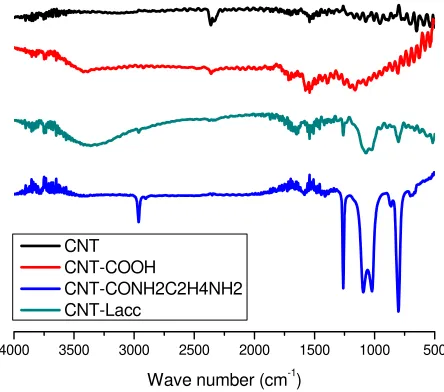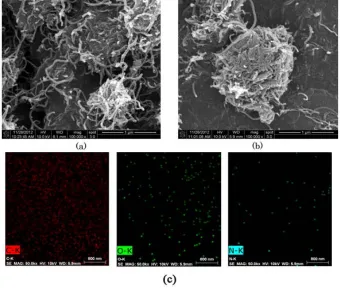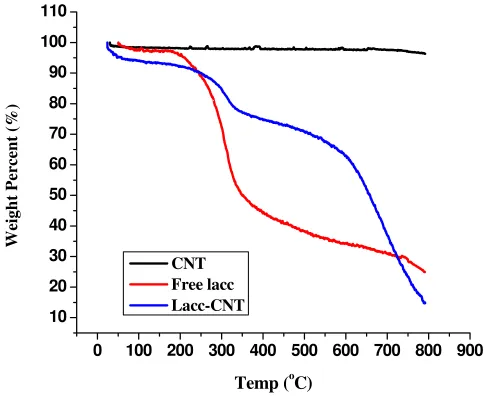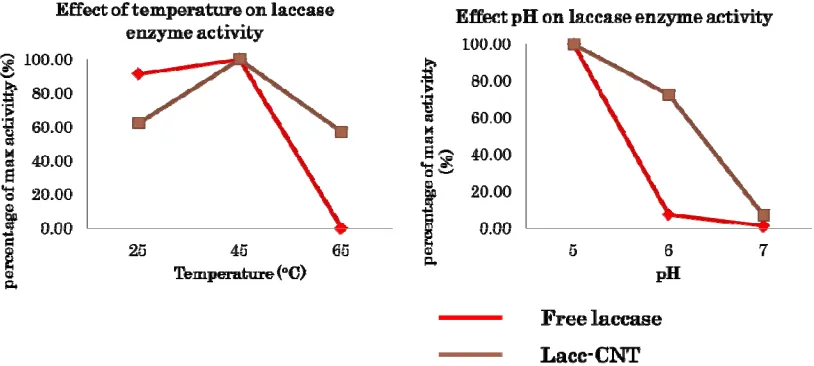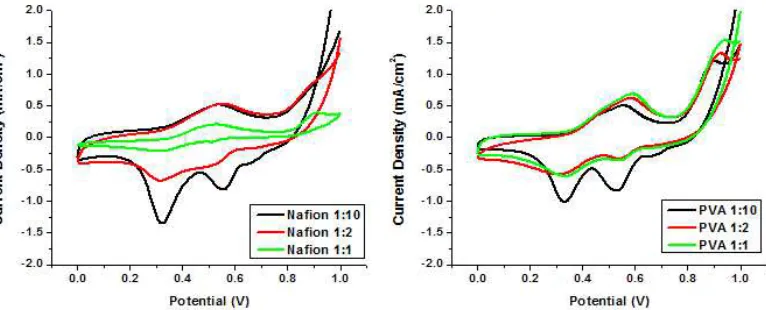The journal homepage www.jpacr.ub.ac.id ISSN : 2302 ‐ 4690
79
Carbon Nanotube Covalently Attached Laccase Biocathode
for Biofuel Cell
Rizmahardian A. Kurniawan*,1,2, Aulanni’am1, Fa-Kueh Shieh2, and Peter P. Chu2
1
Department of Chemistry, Brawijaya University, Jl. Veteran No. 1 Malang 65145, Indonesia 2
Department of Chemistry, National Central University, Taoyuan County 32001, Taiwan
*
Corresponding email : [email protected]
Received 31 May 2013; First revision 2 June 2013; Second 8 July 2013; Accepted 8 July 2013; Published online 8 July 2013 for edition May-August 2013
ABSTRACT
.Biocathode for biofuel cell was prepared by covalently immobilized Laccase on CNT (CNT-Laccase) using glutaraldehyde as conjugates. Successful Laccase immobilization was confirmed by Fourier Transform Infrared (FTIR) Spectrophotometry, Surface Electron Microscopy (SEM) and Thermogravimetric Analysis (TGA). Immobilization affected Laccase enzymatic activity where it boosts the stability at high temperature and neutral pH. At temperature 65ºC, free Laccase completely loss its activity, while CNT-Laccase still retaining 57.12% of its activity at 45ºC. The activity of CNT-Laccase at pH 7 was 7.04% of activity at pH 5 which was higher than that of free Laccase. CNT-Laccase was able to perform oxygen electroreduction with addition ABTS (2,2’-azino-bis(3-ethylbenzo-thiazoline-6-sulfonic acid) as mediator. Performance of oxygen electroreduction activity was also determined by type and composition of binding polymer. Nafion was able to provide better environment for oxygen electroreduction activity compare to polyvinyl alcohol (PVA). Current density resulted in using Nafion in ratio 1:10 to buffer volume was 1.31 mA/cm2, which was higher than that of PVA (1.01 mA/cm2). Increasing of binding polymer ratio into 1:2 and 1:1 undermined oxygen electroreduction activity.
Key word: Laccase, biofuel cell, biocathode, electron transfer, enzyme immobilization
INTRODUCTION
Driven by economic and environmental factors, advance in technology to generate energy must keep continue. Fuel cell which directly converts chemical energy from fuel to electricity, becomes favorable emerging technology, since it meets the requirement of renewable, clean and efficient process [1]. Electricity is generated as the electrons flow through external circuit forced by different potential between fuel oxidation on anode and oxygen reduction on cathode [2]. Platinum-based catalysts have been employed to reduce oxygen in most conventional fuel cell. Although prior studies showed promising results, platinum-based catalysts comprise several challenges in large scale commercial products. The main challenge being the high cost of Pt-based catalysts, electrode passivation due to fuel crosses-over to cathode, and the large overpotential [3].
The journal homepage www.jpacr.ub.ac.id ISSN : 2302 ‐ 4690
80 Pt-based catalyst. Detailed energy calculation of each steps in oxygen reduction has proved that enzyme-based oxygen electroreduction grant lower overvoltage [5]. Third, enzyme is nontoxic, biodegradable, and compatible with living cells body. It is thus a safe and clean technology for environment. Bioelectrode can also be implanted into animal body so as to power up microscale electronic devices [6, 7]. Fourth, enzyme is cheaper than most Pt-based catalysts. Enzyme mass production can be obtained by fermentation process utilizing low-cost growth medium [8, 9].
Laccase is promising copper-containing enzymes that often used as biolectrocatalyst on cathode. It exhibits selective activity towards oxygen reduction into water through four concerted electron transfer processes[10]. Its structure consists of monomeric enzyme with dimension of about 65 x 55 x 45 [11]. The active center of Laccase consists of three types copper atoms, namely T1, T2 and T3 [12, 13]. Performance of biocathode constructed from Laccase is determined by electron transfer from electrode to T1 [14]. Since T1 is buries 6.5 below Laccase surface, electron transfer becomes a challenging issue [11].
Electron transfer from T1 to electrode can be achieved either with or without addition mediator. Laccase mediator such as ABTS (2,2’-azino-bis(3-ethylbenzothiazoline-6-sulfonic acid) is able to bind properly on pocket near T1 of Laccase[15]. Electron transfer is possible since ABTS donate electron to Laccase and sequentially form ABTS+. cation radical and the ABTS2+ dication. ABTS+.cation radical and the ABTS2+dication receive the electron from electrodes to start over the cycle[16]. Mediated electron transfer has been proven to improve biocathode electrochemical performances [17-19]. Yet, mediator leakage and instability can be detrimental which limits the durability of biocathode. For this purpose, more sophisticated immobilization methods are required to retain not only enzymes but also mediator on bioelectrode [20].
The journal homepage www.jpacr.ub.ac.id ISSN : 2302 ‐ 4690
81
EXPERIMENT Materials
Materials that were used in this research are Laccase from Trametesversicolor, carbon nanotube, N,N-dimethyl formamide (DMF/(CH3)2NCHO), disodium hydrogen phosphate (Na2HPO4), ethylene glycol (HOCH2CH2OH), glutaraldehyde (OHC(CH2)3CHO), methanol (CH3OH), nitric acid (HNO3), sodium dihydrogen phosphate (NaH2PO4), sulfuric acid (H2SO4) and thionyl chloride (SOCl2). Laccase was purchased from sigma Aldrich, and used as received. CNT is multiwall carbon nanotube which was purchased from Advanced Nanopower Inc. Other chemical was purchased from sigma Aldrich.
Procedure
CNT amine functionalization. Introduction of amine to CNT carboxylation, acyl chloride formation and amidation (Figure 1) [25]. CNT powder is refluxed with 3:1 mixture of concentrated H2SO4 and HNO3 at room temperature for 1-2 hours, followed by sonicated to 1 M HCl for about 30 minutes [26]. As product, carboxyl CNT (CNT-COOH) was obtained by filtration, continuous washing with deionized water, and drying at 80°C for overnight. CNT-COOH was then stirred in 20:1 mixture of SOCl2 and dried DMF (N,N-dimethyl formamide), at 70°C for 24 h. Acyl chloride CNT (CNT-COCl) was obtained by filtration and drying in vacuum at room temperature. The product was mixed with excessive ethylene diamine and sonicated for 30 minutes. The suspensions were refluxed for 24 h at 50–60°C. The mixture was diluted with methanol, centrifuged and washed with copious amount of methanol. Aminoethylamide CNT (CNT-CONHC2H4NH2) was dried in vacuum.
Laccase attachement to carbon materials. Laccase attached to CNT using glutaraldehyde as conjugate [24]. Glutaraldehyde 5% was reacted to CNT-CONHC2H4NH2 in phosphate buffer pH 7.0 by sonicating for 4 hours and then rotated for 8 hours. The products was washed and centrifuged 3 times with water then excessive Laccase solution was added to modified carbon materials. Reaction was carried out overnight at 20°C. Final products are washed and centrifuged as above.
Biocathode fabrication. Biocathode was fabricated by coating catalyst composites over glass carbon electrode (diameter 5 mm). Glass carbon electrode was polished with alumina powder prior coating. The composite was prepared by mixing 10 mg CNT-Laccase, 500 μL phosphate buffer pH 5, and binding polymer in an evendorph tube. Two kinds of binding polymer were used in this research, Nafion 5% in ethanol and polyvinyl alcohol (PVA) 5% in water. The amount of binding polymer added to composite was also varied, by ratio binding polymer volume to binding buffer volume 1:10, 1:2, and 1:1. The mixture was then mixed thoroughly for 1 minute. Composite contain 120 µg CNT-Laccase was spread on a glass-carbon surface and dried in 5-10 minutes at room temperature under vacuum.
Laccase enzymatic activity assay. Laccase enzymatic activity assay was carried out spectrophometrically based on oxidation of ABTS at 420 nm using ABTS as substrate[27]. Reactive mixture contained 150 µL enzyme solution (either free laccase solution or immobilized laccase suspension), 150 µL ABTS 50 mM, and 1.2 mL buffer. Reactive mixtures were incubated for 7 minute. Temperature was set at 25, 45 and 65°C, while pH was varied at 5, 6, 7.
The journal homepage www.jpacr.ub.ac.id ISSN : 2302 ‐ 4690
82 characterized by cyclic voltammetry. Electrochemical measurements were performed with CH instrument (CHI Instrument Model 611B) using a three-electrode cell. Glass-carbon coated with as prepared biocathode was used as working electrodes, platinum wire as counter electrodes and Ag/AgCl (in saturated KCl) as reference electrodes.
RESULT AND DISCUSSION
Fourrier Transform Infrared Spectra of CNT-Laccase
Figure 1. CNT functionalization and Laccase immobilization
4000 3500 3000 2500 2000 1500 1000 500
Wave number (cm-1) CNT
CNT-COOH
CNT-CONH2C2H4NH2 CNT-Lacc
Figure 2. FTIR Spectra of CNT and derivatives
The journal homepage www.jpacr.ub.ac.id ISSN : 2302 ‐ 4690
83 carboxyl group. Peak around 1600 is related to stretching of CO bond in carboxyl group [28]. Carboxyl group was introduced by treating CNT in 3:1 mixture of concentrated sulfuric acid and nitric acid at room temperature. Acid treatment induced formation of hydroxyl and carboxyl groups especially in end wall or defect sited of carbon nanotubes [29]. CNT-CONHC2H4NH2 was amidation product of CNT-COOH by absence of OH stretching peak at 3300 cm-1. Amine and amide were dominant peaks at FTIR spectrophotometry. FTIR spectra of CNT-CONHC2H4NH2 showed peak at 2970 cm-1, 1580 cm-1, 1050 cm-1 and 790 cm-1, which are related to NH stretching, CO stretching, CN stretching, and NH wagging, respectively. Immobilization of Laccase on CNT changed FTIR spectra significantly. Strong absorption of hydroxyl at wavenumber 3370 cm-1 was appeared, while strong amide bond and amine group was also seen from absorption at 1630 cm-1, 1050 cm-1, 2970 cm-1 (CO stretching, CN stretching, and NH stretching, respectively). Hydroxyl, amine and amide are common functional groups which are possessed by enzyme including laccase. Appearance of hydroxyl, amine and amide peaks of CNT-Laccase confirm that laccase has been succesfully immobilized on CNT.
The journal homepage www.jpacr.ub.ac.id ISSN : 2302 ‐ 4690
84
CNT-Laccase microstructure
Microscopic structure of CNT-Laccase was determined by analyzing SEM figures. The figure was then compared to SEM figure of bare CNT. The result showed functionalization didn’t destroy CNT-tube structure. Laccasseimmobilization also promoted CNT-Laccase to aggregate (Figure 3b). Laccase presence on the aggregation structure was verified by elemental mapping.The structure contained carbon, nitrogen and oxygen for about 91.75%, 3.32%, and 3.86%, respectively in atomic ratio. Oxygen and nitrogen are shown distributed evenly on the structure (Figure 3c), which indicated Laccase presence on CNT structure.
Figure 4. TGA Analysis of Laccase-covalently attached CNT
CNT-Laccase thermal decomposition temperature
The journal homepage www.jpacr.ub.ac.id ISSN : 2302 ‐ 4690
85
Effect of immobilization on Laccase temperature and pH stabilization
Both CNT-Lacc and free Laccase enzymatic activity were determined by UV Visible Spectrophotometry using ABTS as substrate. Free Laccase activity was 2.19 x 10-5 ± 5.25 x10-6 U/mg Laccase at pH 5. Laccase activity decrease as pH increased. At pH 7, the activity was only 1.46% from Laccase activity in pH 5. OH- ions concentration in solution increases at high pH. OH- ions are inhibitor for Laccase activity. They attach to T2/T3 active site of Laccase, therefore it prevents oxygen binding to Laccase [12, 33].
Figure 5. Effect of Temperature and pH to Laccase Enzymatic Activity
Generally, CNT-lacc activity also shown similar trend with free Laccase. Yet, the immobilization gives better resistance to OH- ions. The activity of CNT Laccase at pH 7 was 7.04% of activity at pH 5. This result was higher than free Laccase activity that only 1.46% of activity at pH 5.
In term of temperature, both free Laccase and CNT-lacc was increase by raising temperature from 25ºC to 45ºC. Laccase activity increased from 2.35 x 10-7 ± 1.93 x10-7 to5.78 x 10-7 ± 6.58 x10-8 U/mg Laccase, while CNT-lacc activity increased from 5.78 x 10-7 ± 6.58 x10-8 to 9.55 x 10-7 ± 7.80 x 10-8 U/mg Laccase. At temperature 65ºC, free Laccase completely loss its activity, while CNT Laccase still retaining 57.12% of its activity at 45ºC. Laccase from T. versicolor has been known to retained over 90% of its activity in the temperature range 40-47ºC [34].
Oxygen electroreduction activity of immobilized Laccase
The journal homepage www.jpacr.ub.ac.id ISSN : 2302 ‐ 4690
86 Few possibilities might be responsible to prevent direct electron transfer on the biocathode. First, glutaraldehydes are reactive to lysine or other nucleophilic functional group located on opposite site from laccase active center, they are not able to shuttle the electron to electrodes. Second, Laccase immobilization on CNT might promote laccase and CNT making aggregation, so that, it blocks electron transfer pathway to the electrode. Third, glutaraldehydes are able to polymerize in solution. They might be polymerized so conjugation between CNT and laccase surpass the critical distance to allow direct electron transfers.
Addition of ABTS on biocathode has improved oxygen electroreduction activity. CV profiles showed 2 cathodic peaks and 1 anodic peak. Using Nafion as binding polymer, the cathodic peaks appeared at potential 0.56 V and potential 0.33 V, while the anodic peak appeared at potential 0.54 V. Using PVA as binding polymer, anodic peak and first cathodic peak slightly shifted to 0.55 V and 0.53 V, respectively. Anodic and cathodic peaks around 0.55 V are pair and related to oxidation and reduction of ABTS which has formal potential at 0.48 V. The interaction between ABTS and CNT or GC might shift the potential [18]. Peak at 0.33 V appeared only with presence of oxygen. The peak was related to oxygen electroreduction of the biocathode. Oxygen was reduced when ABTS are available on biocathode. ABTS receive one electron from the electrode, ABTS as then diffused and able to reach the T1 laccase active center. Oxidized ABTS transfer its electron to T1 and return to its reduced state.
Figure 6. CV Profile of CNT-Laccase Biocathode under Oxygen Saturated Phosphate Buffer pH 7 using Different Binding Polymer
The results also showed that type and composition of binding polymer determine oxygen electroreduction activity of biocathode. Nafion provide better environment for Laccase activity on biocathode than that of PVA. Nafion is an acidic polymer which contains sulfonic group in its structure. Therefore, it might create acid local pH than that PVA. Therefore, biocathode composed of Nafion displayed higher current output. At ratio 1:10, oxygen electroreduction peak at CV result higher current density for using nafion as binding polymer (1.31 mA/cm2) compare to PVA (1.01 mA/cm2).
The journal homepage www.jpacr.ub.ac.id ISSN : 2302 ‐ 4690
87 increased from 0.21 mA/cm2 at 1:1 ratio, 0.68 mA/cm2 at 1:2 ratio to 1.31 mA/cm2 at 1:1 ratio. Using PVA as the binding polymer, the highest current density was also achieved at ratio 1:1. The current density at ratio 1:1 and 1:2 were quite similar about 0.61 mA/cm2 and 0.57 mA/cm2, respectively. Less binding polymer used on biocathode, higher current output resulted. It is likely increasing the binding polymer proportion will block mass transfer and electron transfer on biocathode. The result showed that using Nafion by proportion 1:10 to biocathode generates the best current output.
CONCLUSION
Laccase covalently immobilized on CNT has successfully carried out by using glutaraldehyde as conjugates. CNT-Laccase has potential as biocatalyst for biofuel cell. The immobilization improves the stability of laccase under high temperature and neutral pH, which may extend durability of constructed biofuel cell. However, CNT-Laccase was unable to perform oxygen electroreduction activity by direct electron transfer. Oxygen electroreduction activity was improved by addition of ABTS to shuttle electrons from electrode to Laccase active center. We also find that performance of oxygen electroreduction activity was determined by type and composition of binding polymer. Nafion is promising binding polymer, since it provide better oxygen electroreduction activity than that of PVA. Increasingof binding polymer composition into ratios 1:2 and 1:1 decreased oxygen electroreduction activity.
Even though CNT-Laccase showed electroreduction activity after addition of ABTS on the biocathode, the activity lost after five cycles on CV. The loss of activity occurred since the ABTS leak out from biocathode. This research is unable to maintain the activity of CNT-laccase. In the future, two improvements should be made to solve the issue. Laccase is attached on specific site which allows direct electron transfer (DET) to the electrode. Carbohydrate moiety which is located near T1 active center can be made as the target for attachment. As DET is able to be performed, mediator loss is not an issue anymore. The second improvements will be to immobilize both the mediator together with the Laccase, so as to realize a durable bio-fuel cell.
ACKNOWLEDGMENT
This work was supported by the Taiwan National Science Council under contract no. NSC 95-2113-M-008-014-MY3.
REFERENCES
[1] P.P. Edwards, V.L. Kuznetsov, W.I.F. David, N.P. Brandon, Energy Policy, 2008, 36 (12), 4356-4362.
[2] K. Sundmacher, Ind. Eng. Chem. Res., 2010, 49 (21), 10159-10182. [3] S.G. Chalk, J.F. Miller, J. Power Sources, 2006, 159 (1), 73-80.
[4] W. Gellett, J. Schumacher, M. Kesmez, D. Le, S. Minteer, D., J. Electrochem. Soc., 2010, 157 (4), B557-B562.
[5] C.H. Kjaergaard, J. Rossmeisl, J.K. Nørskov, Inorg. Chem., 2010, 49 (8), 3567-3572. [6] L. Halámková, J. Halámek, V. Bocharova, A. Szczupak, L. Alfonta, E. Katz, J. Am.
Chem. Soc., 2012, 134 (11), 5040-5043.
The journal homepage www.jpacr.ub.ac.id ISSN : 2302 ‐ 4690
88 [8] J.L. Toca-Herrera, J.F. Osma, S.R. Couto, Potential of solid-state fermentation for
laccase production, in: A. Mendez-Vilas (Ed.) Communicating Current Research and Educational Topics and Trends in Applied Microbiology, 2007, FORMATEX, Spain. [9] B. Viswanath, M.S. Chandra, H. Pallavi, B.R. Reddy, African J. Biotechnol., 2008, 7
(8), 1129-1133.
[10] D.L. Johnson, J.L. Thompson, S.M. Brinkmann, K.A. Schuller, L.L. Martin,
Biochemistry, 2003, 42 (34), 10229-10237.
[11] K. Piontek, J. Biol. Chem., 2002, 277 (40), 37663-37669.
[12] O.V. Morozova, G.P. Shumakovich, M.A. Gorbacheva, S.V. Shleev, A.I. Yaropolov,
Biochemistry (Moscow), 2007, 72 (10), 1136-1150.
[13] P. Baldrian, FEMS Microbiol. Rev., 2006, 30 (2), 215-242.
[14] S. Shleev, A. Jarosz-Wilkolazka, A. Khalunina, O. Morozova, A. Yaropolov, T. Ruzgas, L. Gorton, Bioelectrochemistry, 2005, 67 (1), 115-124.
[15] F.J. Enguita, J. Biol. Chem., 2004, 279 (22), 23472-23476.
[16] R.P. Ramasamy, H.R. Luckarift, D.M. Ivnitski, P.B. Atanassov, G.R. Johnson, Chem.
Commun., 2010, 46 (33), 6045-6047.
[17] O.V. Morozova, G.P. Shumakovich, S.V. Shleev, Y.I. Yaropolov, Appl. Biochem.
Microbiol., 2007, 43 (5), 523-535.
[18] K. Karnicka, K. Miecznikowski, B. Kowalewska, M. Skunik, M. Opallo, J. Rogalski, W. Schuhmann, P.J. Kulesza, Anal. Chem., 2008, 80 (19), 7643-7648.
[19] C. Vaz-Dominguez, S. Campuzano, O. Rüdiger, M. Pita, M. Gorbacheva, S. Shleev, V.M. Fernandez, A.L. De Lacey, Biosens. Bioelectron., 2008, 24 (4), 531-537.
[20] I. Ivanov, T. Vidaković-Koch, K. Sundmacher, Energies, 2010, 3 (4), 803-846. [21] J.-F. Wu, M.-Q. Xu, G.-C. Zhao, Electrochem. Commun., 2010, 12 (1), 175-177.
[22] X. Wang, P. Sjöberg-Eerola, K. Immonen, J. Bobacka, M. Bergelin, J. Power Sources,
2011, 196 (11), 4957-4964.
[23] K. Sadowska, K. Stolarczyk, J.F. Biernat, K.P. Roberts, J. Rogalski, R. Bilewicz,
Bioelectrochemistry, 2010, 80 (1), 73-80.
[24] E. Nazaruk, M. Karaskiewicz, K. Żelechowska, J.F. Biernat, J. Rogalski, R. Bilewicz,
Electrochem. Commun., 2012, 14 (1), 67-70.
[25] Y. Wang, Z. Iqbal, S.V. Malhotra, Chem. Phys. Lett., 2005, 402, 96–101.
[26] J. Zhang, H. Zou, Q. Qing, Y. Yang, Q. Li, Z. Liu, X. Guo, Z. Du, J. Phys. Chem. B,
2003, 107, 3712-3718.
[27] Y.Z. Airong Li, Liang Xu, Wenqing Zhu and Xingjun Tian, African J. Biochem. Res.,
2008, 2 (8), 181-183.
[28] R.M. Silverstein, F.X. Webster, D.J. Kiemle, Spectrometric identification of organic compounds, 7th ed.,2005, John Wiley & Sons, Hoboken, NJ.
[29] V. Datsyuk, M. Kalyva, K. Papagelis, J. Parthenios, D. Tasis, A. Siokou, I. Kallitsis, C. Galiotis, Carbon, 2008, 46 (6), 833-840.
[30] G.E. Begtrup, K.G. Ray, B.M. Kessler, T.D. Yuzvinsky, H. Garcia, A. Zettl, Phys.
